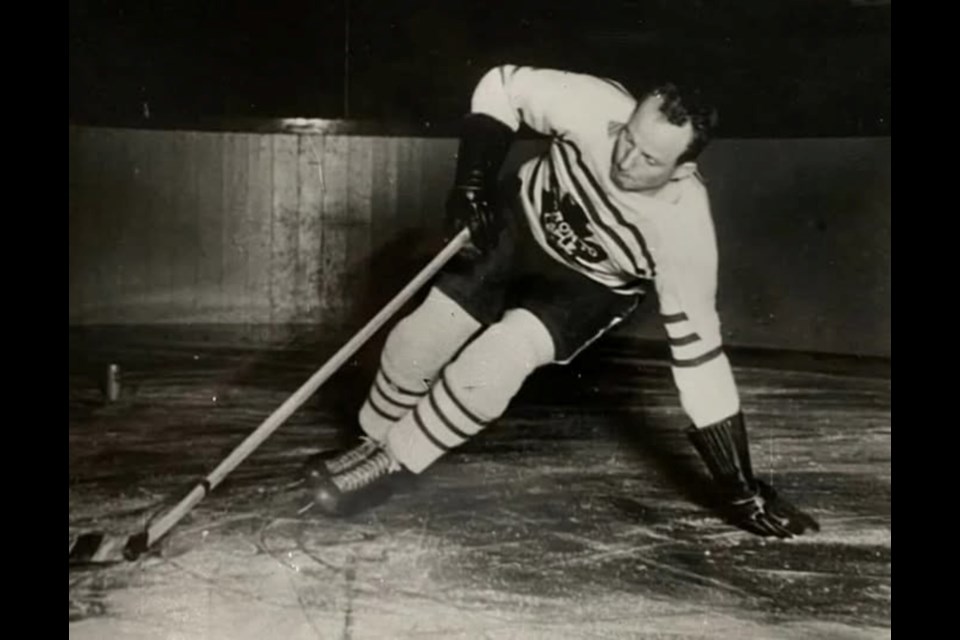This is the first part in a two-part series about hockey legend Clarence 'Hap' Day. The second part will run Monday.
High above the ice surface, in the rafters of Toronto's Scotiabank Arena, a majestic row of banners hang overhead to honour the greatest Maple Leaf players.
With few exceptions they are all there, their images and retired numbers displayed prominently: Teeder Kennedy, Frank Mahovlich, Dave Keon and Red Kelly. King Clancy and Tim Horton. Johnny Bower and Darryl Sittler. The pantheon of the Blue and White.
Among these legends, there is another name that makes the list, one with a local connection.
The short bio on Clarence (Hap) Day says he won seven Stanley Cups with Toronto, the first as team captain, five more coaching the Leafs, and the last as assistant manager. Day had a 14-year playing career in the National Hockey League, and in 1961, he was elected to the Hockey Hall of Fame.
But when you think about it, just how many of today's Leafs Nation – reared on the belief their club's glory years were the Wendel Clark and Doug Gilmour-led playoff runs of 1993 and '94 – would even know who Hap Day was?
And to go further, what number of hockey fans in North Simcoe have ever heard that he had once played for Midland?
A 1921 Census has Day's father, Sidney, living with his family on 6th Avenue in Port McNicoll and working at the freight sheds of the Canadian Pacific Railway. The Days had moved to the Tay Township village from Owen Sound (where Hap was born in 1901) sometime during the previous decade.
Across the latter part of the 1910s, measuring from 1917 to 1920, young Clarence Day was a promising defenceman with the Midland juniors. According to local hockey lore, Day would often walk the five kilometre or so distance between Port McNicoll and Midland to play at the old Casino Rink in the town.
The enclosed wooden structure, with its well-maintained natural ice and stands for spectators, provided a boost for Hap in his hockey development. The late James McCannell, a lifetime resident of Port McNicoll, recalled how the future Hall of Famer would practise his shooting and stickhandling on a frozen patch of land in Port that came to be known as “Day's Pond.”
It's true Hap did indeed begin playing the sport at an early age in his hometown of Owen Sound (he was the captain of the Strathcona public school squad there), but things didn't start getting interesting for Day until he passed through the doors of the Casino Rink to join Midland's junior crew, believed to be his first team in the Ontario Hockey Association.
One can picture Hap back then, in his heavy wool sweater and pants too short, wearing the thin elbow and shin pads that served as protection. There were no helmets in those days and not a curved stick in sight.
Still, aside from the curious hockey gear, he was getting noticed on the ice. In 1920, when the Barrie Colts narrowly defeated Midland, 12 goals to 11, in the OHA Group 10 junior final, the Barrie Examiner reported, “For Midland, the bright particular star was Day, the defenceman who had many brilliant rushes to his credit.”
Around the same time, the Bill Duncan-managed Intermediates travelled to the United States for exhibition games against the Cleveland Athletic Club at the city's palatial Elysium Arena.
Frank (Moose) Moores, who in the 1930s wrote a column for the Midland Free Press called Them Were The Days, remembered Hap making that trip.
He was still only junior-age, but the men of the Midland outfit – including such battle-tested veterans as Ab and Dick Simpell, Clarence Simpson and Percy (Punch) Beatty – must have thought the young call-up good enough to skate with them. And they were right.
During the Ohio contests, Day would grab a blueline spot in front of goaltender Bill McDonald, a one-time police chief of Midland.
As he turned 21, Hap knew that if he wanted to advance farther in hockey, he'd need to leave his adopted home.
That notion grew to be especially useful when, in 1922, he moved up from the intermediate ranks to try his skills at the far tougher senior level in Hamilton.
For two seasons, Day showed he was “one of the best young prospects in Ontario amateur hockey.” He excelled against the higher class of opposition for the OHA's Tigers, proving adept as a rearguard or, when needed, at forward, and was part of Hamilton's provincial championship team of 1924.
By then, Toronto newspapers were routinely using the nickname “Happy” in their stories about Day. How he acquired the moniker is uncertain.
Some accounts state it was “because of his outgoing personality and sense of humour.” Others say it was given to him at birth. Whatever the reason, the nickname seemed a natural fit and had a nice ring to it. Besides, Hap didn't seem to mind at all - he never liked the name Clarence anyway.
Nevertheless, in December of 1924, Toronto St. Pats manager Charlie Querrie would sign “Happy” Day (it was eventually shortened to just Hap) to a professional hockey contract.
“Day comes from Midland,” said The Toronto Star, previewing his NHL debut.
Hap was then attending the Ontario College of Pharmacy at the University of Toronto and starring for the school's Varsity Blues. A past student of Midland High School, Day had gotten his start in the trade while apprenticing at George Ross' (“Ross the Druggist”) pharmacy on King Street. Ross, also a hockey fan, was later the president of Midland Arena Gardens Limited.
